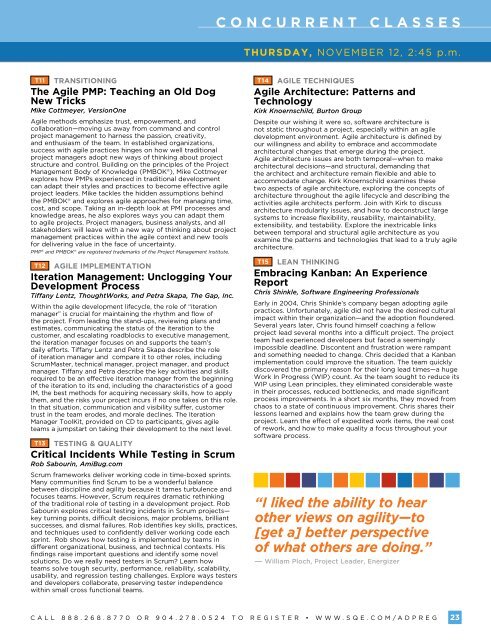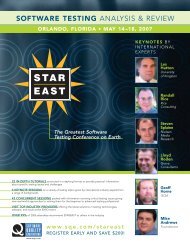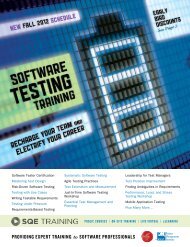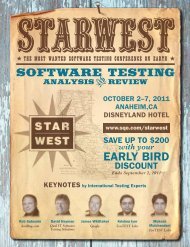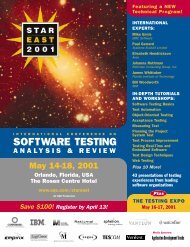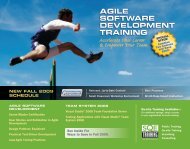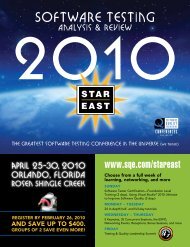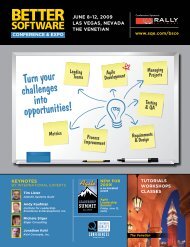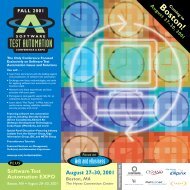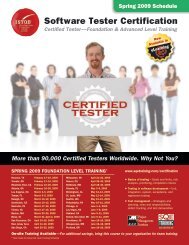Agile Development Practices Conference - SQE.com
Agile Development Practices Conference - SQE.com
Agile Development Practices Conference - SQE.com
Create successful ePaper yourself
Turn your PDF publications into a flip-book with our unique Google optimized e-Paper software.
concurrent classesMONDAY, may 16, 8:30-5:00thursDAY, november 12, 2:45 p.m.T11 TransitioningThe <strong>Agile</strong> PMP: Teaching an Old DogNew TricksMike Cottmeyer, VersionOne<strong>Agile</strong> methods emphasize trust, empowerment, andcollaboration—moving us away from <strong>com</strong>mand and controlproject management to harness the passion, creativity,and enthusiasm of the team. In established organizations,success with agile practices hinges on how well traditionalproject managers adopt new ways of thinking about projectstructure and control. Building on the principles of the ProjectManagement Body of Knowledge (PMBOK ® ), Mike Cottmeyerexplores how PMPs experienced in traditional developmentcan adapt their styles and practices to be<strong>com</strong>e effective agileproject leaders. Mike tackles the hidden assumptions behindthe PMBOK ® and explores agile approaches for managing time,cost, and scope. Taking an in-depth look at PMI processes andknowledge areas, he also explores ways you can adapt themto agile projects. Project managers, business analysts, and allstakeholders will leave with a new way of thinking about projectmanagement practices within the agile context and new toolsfor delivering value in the face of uncertainty.PMP ® and PMBOK ® are registered trademarks of the Project Management Institute.T12 <strong>Agile</strong> ImplementationIteration Management: Unclogging Your<strong>Development</strong> ProcessTiffany Lentz, ThoughtWorks, and Petra Skapa, The Gap, Inc.Within the agile development lifecycle, the role of “iterationmanager” is crucial for maintaining the rhythm and flow ofthe project. From leading the stand-ups, reviewing plans andestimates, <strong>com</strong>municating the status of the iteration to thecustomer, and escalating roadblocks to executive management,the iteration manager focuses on and supports the team’sdaily efforts. Tiffany Lentz and Petra Skapa describe the roleof iteration manager and <strong>com</strong>pare it to other roles, includingScrumMaster, technical manager, project manager, and productmanager. Tiffany and Petra describe the key activities and skillsrequired to be an effective iteration manager from the beginningof the iteration to its end, including the characteristics of a goodIM, the best methods for acquiring necessary skills, how to applythem, and the risks your project incurs if no one takes on this role.In that situation, <strong>com</strong>munication and visibility suffer, customertrust in the team erodes, and morale declines. The IterationManager ToolKit, provided on CD to participants, gives agileteams a jumpstart on taking their development to the next level.T13 Testing & QualityCritical Incidents While Testing in ScrumRob Sabourin, AmiBug.<strong>com</strong>Scrum frameworks deliver working code in time-boxed sprints.Many <strong>com</strong>munities find Scrum to be a wonderful balancebetween discipline and agility because it tames turbulence andfocuses teams. However, Scrum requires dramatic rethinkingof the traditional role of testing in a development project. RobSabourin explores critical testing incidents in Scrum projects—key turning points, difficult decisions, major problems, brilliantsuccesses, and dismal failures. Rob identifies key skills, practices,and techniques used to confidently deliver working code eachsprint. Rob shows how testing is implemented by teams indifferent organizational, business, and technical contexts. Hisfindings raise important questions and identify some novelsolutions. Do we really need testers in Scrum? Learn howteams solve tough security, performance, reliability, scalability,usability, and regression testing challenges. Explore ways testersand developers collaborate, preserving tester independencewithin small cross functional teams.T14 <strong>Agile</strong> Techniques<strong>Agile</strong> Architecture: Patterns andTechnologyKirk Knoernschild, Burton GroupDespite our wishing it were so, software architecture isnot static throughout a project, especially within an agiledevelopment environment. <strong>Agile</strong> architecture is defined byour willingness and ability to embrace and ac<strong>com</strong>modatearchitectural changes that emerge during the project.<strong>Agile</strong> architecture issues are both temporal—when to makearchitectural decisions—and structural, demanding thatthe architect and architecture remain flexible and able toac<strong>com</strong>modate change. Kirk Knoernschild examines thesetwo aspects of agile architecture, exploring the concepts ofarchitecture throughout the agile lifecycle and describing theactivities agile architects perform. Join with Kirk to discussarchitecture modularity issues, and how to deconstruct largesystems to increase flexibility, reusability, maintainability,extensibility, and testability. Explore the inextricable linksbetween temporal and structural agile architecture as youexamine the patterns and technologies that lead to a truly agilearchitecture.T15 Lean ThinkingEmbracing Kanban: An ExperienceReportChris Shinkle, Software Engineering ProfessionalsEarly in 2004, Chris Shinkle’s <strong>com</strong>pany began adopting agilepractices. Unfortunately, agile did not have the desired culturalimpact within their organization—and the adoption floundered.Several years later, Chris found himself coaching a fellowproject lead several months into a difficult project. The projectteam had experienced developers but faced a seeminglyimpossible deadline. Discontent and frustration were rampantand something needed to change. Chris decided that a Kanbanimplementation could improve the situation. The team quicklydiscovered the primary reason for their long lead times—a hugeWork In Progress (WIP) count. As the team sought to reduce itsWIP using Lean principles, they eliminated considerable wastein their processes, reduced bottlenecks, and made significantprocess improvements. In a short six months, they moved fromchaos to a state of continuous improvement. Chris shares theirlessons learned and explains how the team grew during theproject. Learn the effect of expedited work items, the real costof rework, and how to make quality a focus throughout yoursoftware process.“I liked the ability to hearother views on agility—to[get a] better perspectiveof what others are doing.”— William Ploch, Project Leader, EnergizerCall 888.268.8770 or 904.278.0524 to register • WWW.<strong>SQE</strong>.COM/ADPREG23


